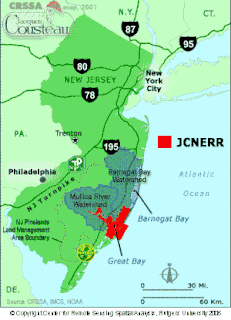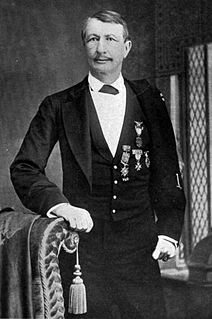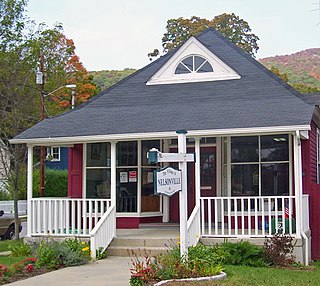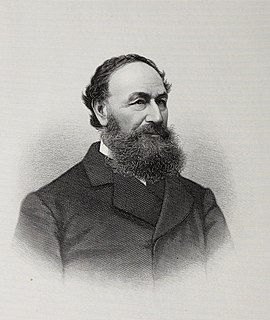
Tivoli is a village in Dutchess County, New York, United States. The population is 1,012, according to the 2020 census. The village, which was incorporated in 1872 from parts of Upper Red Hook Landing and Madalin, is the northernmost settlement in the county, located in the northwestern part of the town of Red Hook. It is part of the Poughkeepsie–Newburgh–Middletown, NY Metropolitan Statistical Area as well as the larger New York–Newark–Bridgeport, NY-NJ-CT-PA Combined Statistical Area. It is entirely within the Hudson River Historic District, a National Historic Landmark. The village is accessible via New York State Route 9G at an intersection with Dutchess County Route 78.

Wells National Estuarine Research Reserve, located in Wells, Maine, USA, is 2,250 acres (9.1 km2) of protected land headquartered at a restored saltwater farm called Laudholm. As a National Estuarine Research Reserve, the Wells Reserve works to expand knowledge of coasts and estuaries, engage people in environmental learning, and involve communities in conservation, all with a goal of protecting and restoring coastal ecosystems around the Gulf of Maine. Wells Reserve funding is largely through the National Oceanic and Atmospheric Administration and the nonprofit Laudholm Trust.

The Jacques Cousteau National Estuarine Research Reserve, located in southeastern New Jersey, encompasses over 110,000 acres (450 km2) of terrestrial, wetland and aquatic habitats within the Mullica River-Great Bay Ecosystem.

John Watts de Peyster, Sr. was an American author on the art of war, philanthropist, and the Adjutant General of New York. He served in the New York State Militia during the Mexican–American War and American Civil War. He was one of the first military critics and noted for his histories of the Revolutionary and Civil Wars, and also published works of drama, poetry, military history, military biography and military criticism.
Rookery Bay Reserve protects 110,000 acres of coastal lands and waters at the northern end of the Ten Thousand Islands on the gulf coast of Florida, Rookery Bay National Estuarine Research Reserve represents one of the few remaining undisturbed mangrove estuaries in North America.

The former Lewis Tompkins Hose Company No. 1 Firehouse, sometimes known as 5/33, was the first built in what later became the city of Beacon, New York. Designed by Schuyler Tillman and Benjamin Hall in a Second Empire style, it was completed in 1893. It is located at 162 Main Street, a block away from NY 9D, and was listed on the National Register of Historic Places on December 6, 2004.

Johnston Livingston de Peyster was a soldier in the Union Army during the American Civil War and later a member of the New York State Assembly from Dutchess County, New York. The son of a wealthy old Dutchess County family, de Peyster joined the Union Army at the age of eighteen. He saw service in the eastern theater, and is best remembered for raising the first Union flag over the Confederate capitol of Richmond, Virginia, after its fall in 1865.

The Hudson River Historic District, also known as Hudson River Heritage Historic District, is the largest Federally designated district on the mainland of the contiguous United States. It covers an area of 22,205 acres extending inland roughly a mile (1.6 km) from the east bank of the Hudson River between Staatsburg and Germantown in Dutchess and Columbia counties in the U.S. state of New York. This area includes the riverfront sections of the towns of Clermont, Red Hook, Rhinebeck and part of Hyde Park. This strip includes in their entirety the hamlets of Annandale, Barrytown, Rhinecliff and the village of Tivoli. Bard College and two protected areas, Margaret Lewis Norrie State Park and Tivoli Bays Unique Area, are also within the district.

The O.H. Booth Hose Company is a former firehouse along Main Street in Poughkeepsie, New York, United States. It was in use for roughly a century, from the late 1910s to the mid-2000s, when the city's police and fire departments consolidated their operations in a new building across the street. A local firefighters' group has proposed turning it into a local fire museum.

The original Fish and Fur Club building is at Main and Pearl Streets in Nelsonville, New York, United States. It is now used as Nelsonville's village hall. In 1982 it was added to the National Register of Historic Places (NRHP).

The Quinsigamond Firehouse is a historic fire station at 15 Blackstone River Road in Worcester, Massachusetts. Completed in 1892, it is a distinctive local example of Romanesque architecture, and served as a local firehouse until 1994. The building was listed on the National Register of Historic Places in 1980. After standing unused for many years, rehabilitation of the property was contemplated by new ownership in 2013 and 2017.

The Hudson River National Estuarine Research Reserve is a National Estuarine Research Reserve in the state of New York.

Waquoit Bay National Estuarine Research Reserve (WBNERR) encompasses open waters, barrier beaches, marshlands and uplands on the south shore of Cape Cod in the towns of Falmouth and Mashpee. The park is managed by the Department of Conservation and Recreation (DCR) and the National Oceanic and Atmospheric Administration.
Designated in 1991, the Chesapeake Bay National Estuarine Research Reserve - Virginia (CBNERR-VA) is one of 29 protected areas that make up the National Estuarine Research Reserve System (NERRS). Established to promote informed management of the nation's estuaries and coastal habitats, national estuarine research reserves inspire solutions for healthy coasts and maintain strong local economies, effectively functioning as America's bridge between freshwater and salt.

Portland Fire Station No. 7, located in southeast Portland in the U.S. state of Oregon, is a two-story structure listed on the National Register of Historic Places. Built in 1927, it was added to the register in 1989. It was the last of numerous Portland firehouses to be designed by fire chief and architect Lee Gray Holden, who died of a stroke while visiting the No. 7 firehouse in 1943. The building continued to be used by the city's Fire Department until the 1980s, when it was sold off and used as an automobile garage. It was acquired by a local developer in 2009, and was restored and remodeled for office and retail use.

Frederic de Peyster II was a New York City lawyer and prominent member of the De Peyster family.

The Lake Superior National Estuarine Research Reserve includes land and water areas along the St. Louis River and Lake Superior in Douglas County, in the northwest corner of Wisconsin, United States. It is one of 29 National Estuarine Research Reserves. The Reserve is operated as a program of the Natural Resources Institute of the University of Wisconsin-Madison Division of Extension. It has an area of 16,697 acres (6,757 ha), and was designated in 2010.
De Peyster is a surname of Dutch origin. It is also a town, De Peyster, New York.

Museo Parque de Bombas is a museum located inside the historic Parque de Bombas in the Ponce Historic Zone in Ponce, Puerto Rico.




















